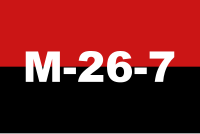26th of July Movement
| 26th of July Movement | |
|---|---|
|
Movimiento 26 de Julio Participant in Cuban Revolution |
|

A modern impression of one of the flags of the 26th of July Movement
|
|
| Active | 1955–1965 |
| Ideology |
Communism Left-wing nationalism Anti-imperialism Vanguardism Christian left Revolutionary Socialism |
| Leaders |
Fidel Castro (head) Raúl Castro Che Guevara Camilo Cienfuegos Juan Almeida Bosque |
| Headquarters |
Tuxpan, Veracruz, Mexico (first) Havana, Cuba (second) |
| Area of operations | Caribbean Sea |
| Became | Communist Party of Cuba |
| Opponents | Fulgencio Batista's Government, Cuban Army |
| Battles and wars | Operation Verano, Battle of La Plata, Battle of Las Mercedes, Battle of Yaguajay, Battle of Santa Clara |
The 26th of July Movement (Spanish: Movimiento 26 de Julio; M-26-7) was a vanguard revolutionary organization led by Fidel Castro that in 1959 overthrew the Fulgencio Batista dictatorship in Cuba. The Movement fought the Batista regime on both rural and urban fronts. The movement’s main objectives were distribution of land to peasants, nationalization of public services, industrialization, honest elections, and large scale education reform.
The 26th of July Movement's name originated from the failed attack on the Moncada Barracks, an army facility in the city of Santiago de Cuba, on 26 July 1953. This attack was led by a young Fidel Castro, who was a legislative candidate in a free election that had been cancelled by Batista. The failed attack had been intended as a rallying cry for the revolution. Castro was captured and sentenced to 15 years in prison but along with his group was granted an amnesty after two years following a political campaign on their behalf. Castro travelled to Mexico to reorganize the movement in 1955 with several other exiled revolutionaries (including Raúl Castro, Camilo Cienfuegos, and Juan Almeida Bosque). Their task was to form a disciplined guerrilla force to overthrow Batista.
On 2 December 1956, 82 men landed in Cuba, having sailed in the boat Granma from Tuxpan, Veracruz, ready to organize and lead a revolution. The early signs were not good for the movement. They landed in daylight, were attacked by the Cuban Air Force, and suffered numerous casualties. The landing party was split into two and wandered lost for two days, most of their supplies abandoned where they landed. They were also betrayed by their peasant guide in an ambush, which killed more of those who had landed. Batista mistakenly announced Fidel Castro's death at this point. Of the 82 who sailed aboard the Granma, only 12 eventually regrouped in the Sierra Maestra mountain range. While the revolutionaries were setting up camp in the mountains, "Civic Resistance" groups were formulating in the cities putting pressure on the Batista regime. Many middle-class and professional persons flocked toward Castro and his movement. While in the Sierra Maestra mountains the guerrilla forces attracted hundreds of cuban volunteers and won several battles against the Cuban Army. Ernesto 'Che' Guevara was shot in the neck and chest during the fighting, but was not severely injured. (Guevara, who had studied medicine, continued to give first aid to other wounded guerrillas.) This was the opening phase of the war of the Cuban Revolution, which continued for the next two years. It ended in January 1959, after Batista fled Cuba for Spain, on New Year's Eve when the Movement's forces marched into Havana.
...
Wikipedia
